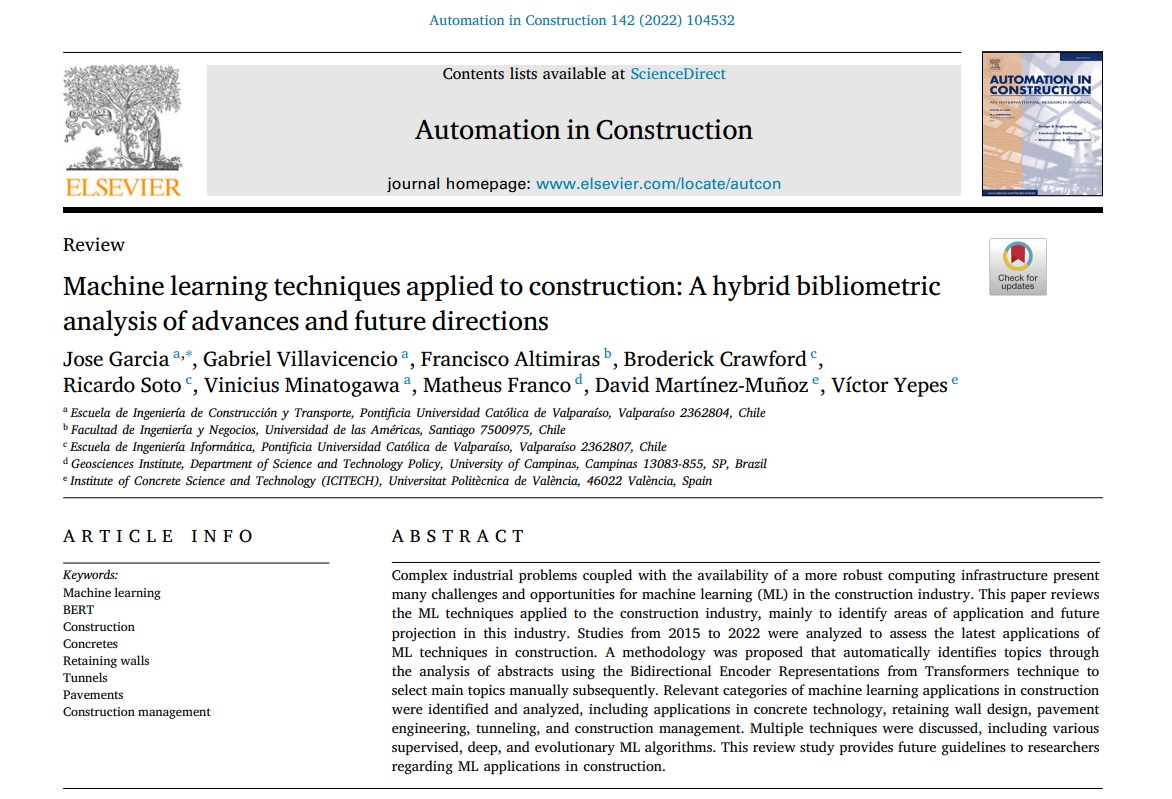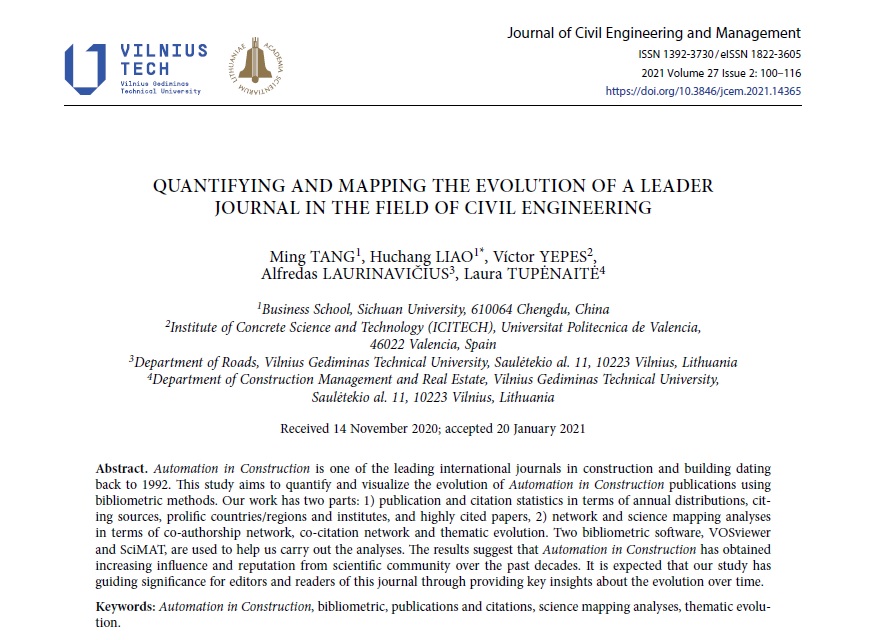 Acaban de publicarnos un artículo en la revista Automation in Construction, que es la revista indexada de mayor impacto JCR en el ámbito de la ingeniería civil. En este caso se ha realizado un análisis bibliométrico del estado del arte y de las líneas de investigación futura del Machine Learning en el ámbito de la construcción. El trabajo se enmarca dentro del proyecto de investigación HYDELIFE que dirijo como investigador principal en la Universitat Politècnica de València. En este caso, se trata de una colaboración con grupos de investigación de Chile, Brasil y España.
Acaban de publicarnos un artículo en la revista Automation in Construction, que es la revista indexada de mayor impacto JCR en el ámbito de la ingeniería civil. En este caso se ha realizado un análisis bibliométrico del estado del arte y de las líneas de investigación futura del Machine Learning en el ámbito de la construcción. El trabajo se enmarca dentro del proyecto de investigación HYDELIFE que dirijo como investigador principal en la Universitat Politècnica de València. En este caso, se trata de una colaboración con grupos de investigación de Chile, Brasil y España.
El artículo lo puedes descargar GRATUITAMENTE hasta el 11 de octubre de 2022 en el siguiente enlace: https://authors.elsevier.com/c/1fdIq3IhXMtgv2
Los complejos problemas industriales, junto con la disponibilidad de una infraestructura informática más robusta, presentan muchos retos y oportunidades para el aprendizaje automático (Machine Learning, ML) en la industria de la construcción. Este artículo revisa las técnicas de ML aplicadas a la construcción, principalmente para identificar las áreas de aplicación y la proyección futura en esta industria. Se analizaron estudios desde 2015 hasta 2022 para evaluar las últimas aplicaciones de ML en la construcción. Se propuso una metodología que identifica automáticamente los temas a través del análisis de los resúmenes utilizando la técnica de Representaciones Codificadoras Bidireccionales a partir de Transformadores para posteriormente seleccionar manualmente los temas principales. Hemos identificado y analizado categorías relevantes de aplicaciones de aprendizaje automático en la construcción, incluyendo aplicaciones en tecnología del hormigón, diseño de muros de contención, ingeniería de pavimentos, construcción de túneles y gestión de la construcción. Se discutieron múltiples técnicas, incluyendo varios algoritmos de ML supervisado, profundo y evolutivo. Este estudio de revisión proporciona directrices futuras a los investigadores en relación con las aplicaciones de ML en la construcción.
Highlights:
- State-of-the-art developed using natural language processing techniques.
- Topics analyzed and validated by experts for consistency and relevance.
- Topics deepened through application of bigram analysis and clustering in addition to traditional bibliographic analysis.
- Identified five large areas, and detailed two to three groups of relevant lines of research.
Abstract:
Complex industrial problems coupled with the availability of a more robust computing infrastructure present many challenges and opportunities for machine learning (ML) in the construction industry. This paper reviews the ML techniques applied to the construction industry, mainly to identify areas of application and future projection in this industry. Studies from 2015 to 2022 were analyzed to assess the latest applications of ML techniques in construction. A methodology was proposed that automatically identifies topics through the analysis of abstracts using the Bidirectional Encoder Representations from Transformers technique to select main topics manually subsequently. Relevant categories of machine learning applications in construction were identified and analyzed, including applications in concrete technology, retaining wall design, pavement engineering, tunneling, and construction management. Multiple techniques were discussed, including various supervised, deep, and evolutionary ML algorithms. This review study provides future guidelines to researchers regarding ML applications in construction.
Keywords:
Machine learning; BERT; Construction; Concretes; Retaining walls; Tunnels; Pavements; Construction management
Reference:
GARCÍA, J.; VILLAVICENCIO, G.; ALTIMIRAS, F.; CRAWFORD, B.; SOTO, R.; MINTATOGAWA, V.; FRANCO, M.; MARTÍNEZ-MUÑOZ, D.; YEPES, V. (2022). Machine learning techniques applied to construction: A hybrid bibliometric analysis of advances and future directions. Automation in Construction, 142:104532. DOI:10.1016/j.autcon.2022.104532


